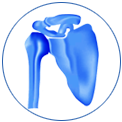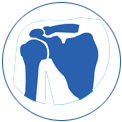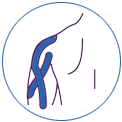Dr Gautam Tawari is one the best arthroscopist and has performed more than 2000 Shoulder arthroscopies. He has also proficiently performed primary Orthopedic Shoulder Replacements (Anatomic & Reverse) and more complex procedures like Revision Shoulder Replacements.
Orthopedic Shoulder Arthroscopy is a surgical technique to visualise, diagnose and treat problems inside the shoulder joint. Small incisions on the skin allow a pencil-sized camera and instruments to address the shoulder pain. Arthroscopic surgery allows for early rehabilitation, faster recovery and lesser pain.
Dr Tawari is a ex-UK consultant and is an fellowship trained Orthopedic Shoulder Arthroscopy surgeon in Mumbai. He is an Accredited Sports surgeon from The royal college of surgeon, UK.

The acromioclavicular joint (ACJ) is a small joint between your collar bone (clavicle) and the part of your shoulder blade (scapula) known as the acromion.
Cause
The causes for pain in the ACJ are as follows:
- Trauma: Sports injuries and a fall on the shoulder.
- Osteoarthritis: Mostly seen in adults over the age of 30.
- Repetitive strain that may be due to sudden increases in activity.
- Bone injuries of the clavicle.
Presentation
Pain over the top of the shoulder reproducible with pressure on the top of the shoulder joint. Pain present on lying on the side and increasing with overhead movements. Pain may also increase by lifting or carrying or trying to touch opposite shoulder. A small bump at the end of the collar bone can be felt.
Treatment
- Rest in case of pain from injuries.
- Activity Modification.
- Simple pain killers and anti-inflammatories.
- Physiotherapy may help to maintain and improve your muscle strength to prevent further problems.
- A steroid injection into the AC joint may help to reduce inflammation and pain.
- Surgery is considered if other treatments do not provide benefit. The surgical technique most commonly used is arthroscopic excision of lateral end of clavicle (keyhole surgery).
Recovery
After surgery, the arm is rested in a sling for 1-2 weeks. A phased exercise programme starts at 2 weeks and continues for 4-6 weeks. Full recovery is generally acquired by 3 months.
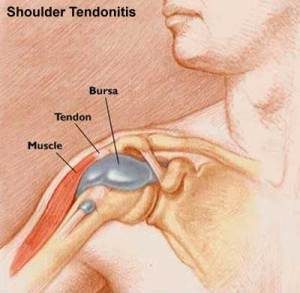
Any abnormality resulting in dysfunctioning of the rotator cuff causes it to rub against the Acromion (upper bone arch) resulting in inflammation of the bursa causing pain. This occurs each time the shoulder is moved and is called impingement.
Cause
Pathologies affecting the rotator cuff are :-
Direct causes:
- Rotator cuff strain
- Partial or full thickness tear
- Calcific tendonitis
- A tendonopathy due to chronic overuse.
Indirect causes:
- Glenohumeral instability
- Labral tears, in particular SLAP tears
- Abnormal muscle patterning problems of the shoulder.
Presentation
Pain that is sharp in nature and associated with movement of the shoulder. Pain can also affect sleep. Shoulder moves fully but with pain.
Treatment
Treatment includes:
- Painkillers and anti-inflammatory medications
- Physiotherapy – Strengthening of the weakened rotator cuff muscles
- Injections – reduces inflammation and control the pain, allows the rotator cuff muscles a chance to recover and improve with the exercises
- Surgery – Increasing the amount of space between the acromion and the rotator cuff tendons, which will then allow for easier movement and less pain and inflammation. The operation performed is called Arthroscopic Subacromial Decompression (ASD)
Recovery
After surgery, a sling is provided for 2-3 weeks only for comfort and the shoulder joint is allowed to be moved. Physiotherapy goes through 3 phases and full recovery generally takes 6 weeks to 12 weeks.
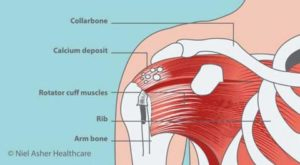
Calcific tendinitis (or tendonitis) occurs when calcium deposits builds up in the rotator cuff tendon. Calcific tendonitis is one of the most common causes of shoulder pain. Associated with performance of a lot of overhead motions, such as heavy lifting, or play sports like basketball or tennis.
Cause
Its thought that calcium buildup may stem from:
- Genetic Predisposition
- Abnormal Cell Growth
- Abnormal Thyroid Gland Activity
- Bodily Production of Anti-inflammatory Agents
- Metabolic Diseases, Such as Diabetes
Although it’s more common in people who play sports or routinely raise their arms up and down for work, calcific tendonitis can affect anyone.
Presentation
The most common complaint is pain. The pain worsens with activities, especially with any activities that require the arms to reach over the head, and often affects sleep. Pain is sharp and unbearable. Restricted movements associated with pain is also present.
Treatment
Non-steroidal anti-inflammatory medication form the mainstay of treatment. Physiotherapy helps to maintain movement and strengthen of shoulder.
Steroid injections provide relief, but this is often temporary.
Ultrasound guided needling of the tendon undertaken by experienced surgeon can provide relief of symptoms and may prevent surgery.
Surgery is recommended if the pain is intractable and not relieved with pain killers. The surgical technique most commonly used is shoulder arthroscopy with removal of calcium deposit carefully from within the tendon.
Recovery
After surgery, the arm is rested in a sling for 1-2 weeks. A Phased exercise programme starts at 2 weeks and continues for 4-6 weeks. Full recovery is generally acquired by 3 months.
Biceps Tendon
The biceps is a muscle in the upper arm that helps bend the elbow. It has a tendon in the shoulder joint.
Cause
This is caused by mechanical injury to the tendon heavy lifting and different types of sporting activities. Biceps tendon subluxation results in the setting of a subscapularis tear where the biceps actually dislocates from its normal position in the shoulder.
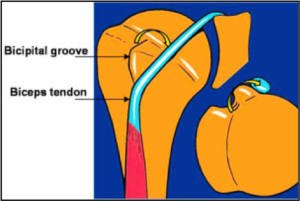
Presentation
The most common complaint is pain in front of the shoulder; however, symptoms can be consistent with rotator cuff tears or arthritis of shoulder. These include pain with activity/overhead motion, weakness, and night pain. Motions such as bending the elbow, carrying heavy weights, and throwing movements can cause pain. On rare occasion, patients may feel a “pop” in the shoulder that is followed by severe pain.
Treatment
Initial treatment is non-operative management. This includes anti-inflammatory medications & activity modification. If pain continues surgery may be required to alleviate pain.
Arthroscopic surgery involves either biceps tenotomy (cutting the tendon and letting it retract) or biceps tenodesis (cutting the tendon and pinning it to the arm bone). The downside of biceps tenotomy is appearance of a “popeye” deformity as the cut tendon retracts down the arm. Biceps tenodesis avoids the popeye deformity but the surgery may require an open incision. Recovery is prolonged after a tenodesis in comparison to a tenotomy.
Recovery
A sling is required for the first 3 weeks, similar to a rotator cuff repair. In contrast, patients who have undergone a biceps tenotomy can return to activities as soon as they feel comfortable.
A dislocating biceps tendon in addition also requires repair of the torn subscapularis tendon.
Shoulder arthroscopy according to Dr Gautam Tawari – one of the premier shoulder surgeon in Mumbai is a medical term given to a minimally invasive form of surgery for shoulder replacement cases, shoulder sports injuries cases, and frozen shoulder cases – where a miniature camera with a pen-like construction is inserted into a tiny incision made into the target area of the shoulder region of a patient. The doctor then received real-time footage of the inside of the patient’s shoulder on a monitor that helps him or her to guide miniature but precise medical instruments in a bid to repair the issues with the shoulder of the patient.
BenefitsAs per Dr Gautam – one of the most reputed shoulder surgeon in Navi Mumbai, there are other more invasive surgical procedures to solve shoulder related afflictions but with shoulder arthroscopy, one can expect to –
- Heal faster and
- Recover with almost hard-to-spot scar(s).
Furthermore, the patient will be able to remain awake during the procedure as instead of general anaesthesia, the best shoulder surgeon in Mumbai will be using local block anaesthesia so that the affliction affecting the cartilage, ligaments, or the rotator cuff of the patient’s shoulder is restored back to its original state in no time.
Are there any risks?Yes, there are minimal risks associated with the minimally invasive surgical procedure and they range between –
- Infections
- Pain and
- Post-surgery stiffness – all of which are quite manageable.
Post-procedure recovery?
The patient can get back to his or her daily routine on the same day he or she has received the treatment but there is a catch – one would need to pop quite a few pain medications since it is the only way to keep post-procedure pain at bay or at least under manageable limits.
Recovery time can range anywhere between days to almost a year. On top of this, the patient would need to steer clear from strenuous activities like –
- Driving
- Sitting long hours in front of their computers
- Writing countless pages or
- Participate in their preferred sports activity.
